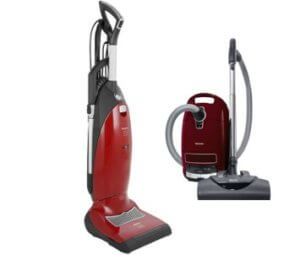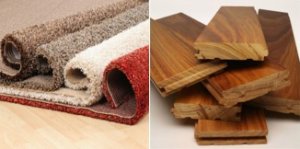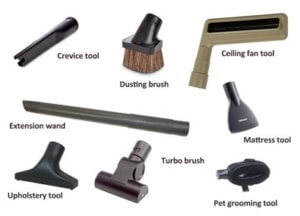When one decides to buy a vacuum cleaner, almost everyone walking through our door has a vague idea of the type of vacuum cleaner purchase they plan to make. And what they want is invariably what they’ve become accustomed to over the years. Rarely do they re-examine their needs. For those of us that are… ahem… a bit older, it’s even rarer.
Here’s our approach.
Know What Type of Vacuum You Want
Even though you should consider your specific needs when choosing between an upright and canister, you’re usually safest to go with what you know. It sounds silly but we (Vacuum Center of North Myrtle Beach) see an increased frequency of returns when the buyer chooses a type of vacuum they have little history with.

Upright vs. Canister has been argued since the Taft administration.
Upright vacuums tend to be a bit easier to use (especially for larger areas). Canisters can go places that most uprights can’t. Uprights are usually heavier and less maneuverable, but canisters get stuck on things as you pull them around. Despite these differences – and others – they’re rarely enough to sway your decision either way. Sticking with what you know is the usually best approach.
Make Your Decision Logically by Asking Yourself a Few Questions
Carpet or Hard Surface? Both?

Mentally walking through the types of flooring you have can really help guide your decision. Assessing the types of surfaces you need to vacuum will help determine the kind of “head” needed… “power”, “turbo”, or “suction”. The head is the part of the vacuum that touches the floor.
A power-heads has an electrically driven brushroll in it that spins at an incredible speed. Its function is to shake the carpet so the vacuum can do its job… sucking up the dirt. A turbo-head is similar insofar as it has a spinning brushroll. The key difference with a turbo-head is that the brushroll isn’t driven by electricity. Instead, it’s driven by suction of the vacuum. A suction-head doesn’t have a brushroll at all. It’s just meant to suck debris up via the vacuum.
If you’re planning on vacuuming a lot of soft surfaces (e.g. high-pile carpets, area rugs, etc.) then a brushroll is pretty much mandatory. It can be either a power-head or a turbo-head. If you just have hard surfaces to vacuum, then a vacuum with a straight suction-head will suffice.
But what if you have both… say wood or tile floors with several area rugs? Many models of vacuum cleaners have the feature of turning the brushroll off (or slowing it way down) for hard surfaces and speeding it up again for area rugs. Ask your vacuum dealer about these features while you shop.
Need Tools?
Folks often forget but many vacuums can be used for a variety of purposes. If you’d like to use your new cleaner on your sofa, drapes, beds, or car, then you’ll need tools. It’s only after you become accustomed to using tools that you find you can’t live without them…

- Use a dusting brush to suck dust from the air-conditioning vents in your car or get the crumbs out of the console.
- There are crevice tools that reach all the way under your refrigerator, stove or way down into your couch.
- There’s a tool for reaching over your ceiling fan blades and sucking the dust from there.
- There’s a tool for cleaning your blinds (yes in between each blind).
- There’s even a tool to brush your dog while sucking up the sheded fur.
- Remember the Flowbee? Yep… a vacuum cleaner tool that cuts your hair.
Not everyone has a need for tools though. If you don’t need them or likely won’t use them, don’t waste the money for them. They only add weight and cost to the vacuum.
Have Pets or Breathing Issues?
Dust, pollen and especially pet dander can wreak havoc on breathing… Duh. But different machines have differences in filtration capabilities. There are paper filters, filter cartridges, foam filters, cloth filters and a number of other types. Some are better performing than others. You’ve undoubtedly heard of HEPA filters. HEPA stands for ‘high efficiency particulate air’ filters. To qualify as HEPA by US government standards, the filter must remove 99.97% of particles that have a size of 0.3 microns or larger.
Many vacuum cleaners use HEPA filters, but not all. If you have doubts about whether or not they’re worth the cost, HEPA filtration is used in a lot of applications beyond vacuum cleaners… airlines, hospitals and research labs to name a few. HEPA filtration works and is about the best you’re going to get in a vacuum cleaner.
Charcoal filters are making a bit of a comeback too. They’re meant to reduce pet odors.
Yeah, we love our pets but know how they can stink up a room. These odors are particularly hard to get rid of. Pet dander and fur are especially insideous because they so often still have the animal’s natural oils attached. These oils attach to EVERYTHING including a vacuum cleaner’s brushroll, hose, filters, bag or dust cup (in the case of bagless models). Worse still, the next time you vacuum, the air passing through the machine picks up these odors AGAIN and distributes them throughout the room. Thank God for nose blindness.

One thought on “Love the next vac you buy!”
Click the links. They’re hilarious.